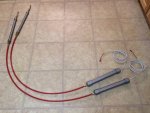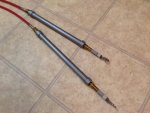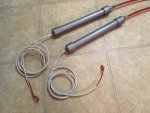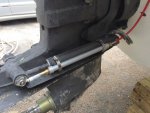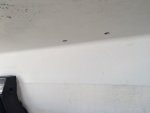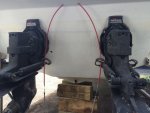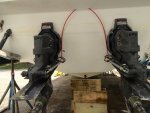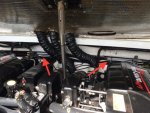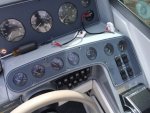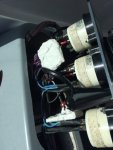- Joined
- Jul 18, 2011
- Messages
- 18,845
I have been working on a project to replace the standard Mercruiser trim indicators with something that would be far more accurate. There are mechanical trim indicators available in the performance market, but those have some short comings in that they usually only monitor the lower end of the trim range and they take up extra space on the instrument cluster at the helm.
My previous boat had one of the mechanical indicators and it was pretty good for precisely setting the trim. My current boat has the standard type and it has been a nightmare knowing the trim (or tilt) of the outdrives. (twin engines)
So, I have been kicking around an idea of having a mechanical indicator that would work throughout the full trim & tilt range of the outdrive. Another forum member 'Mischief Managed' and I have discussed the idea over a couple of lunches during the past couple of years. I wanted to come up with a system that would use the trim cylinder's travel as a more true indication of the outdrive's position, and something that would also work with the existing gauge at the helm. . . since I have little extra space for another gauge/display.
Through several conceptual iterations, I have come up with a system that I plan on trying out on my boat this year to see if it will work for real. It is a combination of a mechanical trim indicator and an electrical indicator. The system has 3 main parts.
1) Trim Cylinder Actuator
2) Mechanical/Electrical Converter
3) Standard Trim Gauge Interface
Today, I finished a working system that I can install in the boat.
Here are parts #1 & #2 connected by a Morse C33 cable.
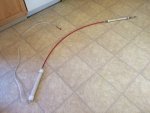
#1) The Actuator will mount to one of the trim cylinders on the outdrive and move the cable through its 8" of travel. Here it is fully collapsed (Full trim down)
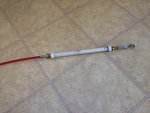
Here it is fully extended (Full Tilt up)

#2) The Converter is merely a large slide potentiometer that changes its resistance over the 8" of travel transferred to it by the cable. The electrical connections are the same as the standard trim sender unit, and essentially replaces it. This unit goes inside the engine compartment in the area of the transom.

#3 ) The Interface unit at the helm connects to the existing gauge wiring at the helm and changes the resistance range of the 8" potentiometer to the range that the gauge expects to see. It is just a simple transistor circuit that I made, and also has a 'trim resistor' for adjusting the gauge reading.
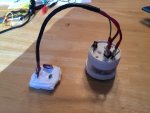
I was trying to make the Actuator (#1) and the Converter (#2) as a single unit, which would mean some of the electrical stuff would have to go under water. However, I felt that was going to be too challenging. So I went with a separate mechanical unit, which goes under water, and a converter which mounts inside the engine bay on the transom.
My testing of the system has demonstrated a very smooth and consistent gauge needle movement for the movement of the trim cylinder unit. So, I am looking forward to trying this out on the boat.
I still have a few more tweaks to make and I still need to make a second unit, since I have twin engines. My plan is to see how well they work and hold up in the marine environment, etc.
Just wanted to share my project and I will post updates as I install, test and use the system throughout the boating season.
My previous boat had one of the mechanical indicators and it was pretty good for precisely setting the trim. My current boat has the standard type and it has been a nightmare knowing the trim (or tilt) of the outdrives. (twin engines)
So, I have been kicking around an idea of having a mechanical indicator that would work throughout the full trim & tilt range of the outdrive. Another forum member 'Mischief Managed' and I have discussed the idea over a couple of lunches during the past couple of years. I wanted to come up with a system that would use the trim cylinder's travel as a more true indication of the outdrive's position, and something that would also work with the existing gauge at the helm. . . since I have little extra space for another gauge/display.
Through several conceptual iterations, I have come up with a system that I plan on trying out on my boat this year to see if it will work for real. It is a combination of a mechanical trim indicator and an electrical indicator. The system has 3 main parts.
1) Trim Cylinder Actuator
2) Mechanical/Electrical Converter
3) Standard Trim Gauge Interface
Today, I finished a working system that I can install in the boat.
Here are parts #1 & #2 connected by a Morse C33 cable.

#1) The Actuator will mount to one of the trim cylinders on the outdrive and move the cable through its 8" of travel. Here it is fully collapsed (Full trim down)

Here it is fully extended (Full Tilt up)

#2) The Converter is merely a large slide potentiometer that changes its resistance over the 8" of travel transferred to it by the cable. The electrical connections are the same as the standard trim sender unit, and essentially replaces it. This unit goes inside the engine compartment in the area of the transom.

#3 ) The Interface unit at the helm connects to the existing gauge wiring at the helm and changes the resistance range of the 8" potentiometer to the range that the gauge expects to see. It is just a simple transistor circuit that I made, and also has a 'trim resistor' for adjusting the gauge reading.

I was trying to make the Actuator (#1) and the Converter (#2) as a single unit, which would mean some of the electrical stuff would have to go under water. However, I felt that was going to be too challenging. So I went with a separate mechanical unit, which goes under water, and a converter which mounts inside the engine bay on the transom.
My testing of the system has demonstrated a very smooth and consistent gauge needle movement for the movement of the trim cylinder unit. So, I am looking forward to trying this out on the boat.
I still have a few more tweaks to make and I still need to make a second unit, since I have twin engines. My plan is to see how well they work and hold up in the marine environment, etc.
Just wanted to share my project and I will post updates as I install, test and use the system throughout the boating season.
Last edited:




















